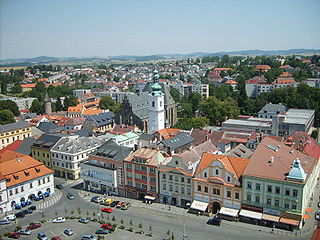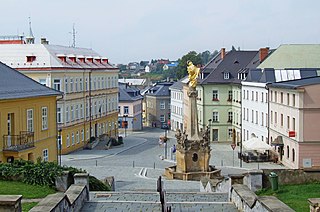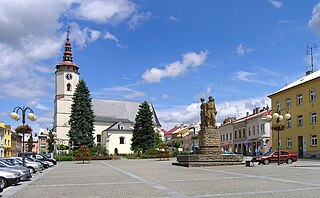
Znojmo is a town in the South Moravian Region of the Czech Republic. It has about 34,000 inhabitants. Znojmo is the historical and cultural centre of southwestern Moravia and the second most populated town in the South Moravian Region. The historic centre of Znojmo is well preserved and is protected by law as an urban monument reservation.

Mohelnice is a town in Šumperk District in the Olomouc Region of the Czech Republic. It has about 9,600 inhabitants. The historic town centre is well preserved and is protected by law as an urban monument zone.

Hlučín is a town in Opava District the Moravian-Silesian Region of the Czech Republic. It has about 13,000 inhabitants. It was the centre of the historic Hlučín Region. The historic town centre is well preserved and is protected by law as an urban monument zone.

Domažlice is a town in the Plzeň Region of the Czech Republic. It has about 11,000 inhabitants. The historic town centre is well preserved and is protected by law as an urban monument reservation.

Klatovy is a town in the Plzeň Region of the Czech Republic. It has about 23,000 inhabitants. The historic town centre is well preserved and is protected by law as an urban monument zone.

Šumperk is a town in the Olomouc Region of the Czech Republic. It has about 25,000 inhabitants. It is an industrial town, but it also contains valuable historical and architectural monuments. The historic town centre is well preserved and is protected by law as an urban monument zone.

Uherský Brod is a town in Uherské Hradiště District in the Zlín Region of the Czech Republic. It has about 16,000 inhabitants. The historic town centre is well preserved and is protected by law as an urban monument zone.

Šternberk is a town in Olomouc District in the Olomouc Region of the Czech Republic. It has about 13,000 inhabitants. It is known for the Šternberk Castle. The historic town centre is well preserved and is protected by law as an urban monument zone.

Příbor is a town in Nový Jičín District in the Moravian-Silesian Region of the Czech Republic. It has about 8,400 inhabitants. The historic centre of Příbor is well preserved and is protected by law as an urban monument reservation.

Vyškov is a town in the South Moravian Region of the Czech Republic. It has about 20,000 inhabitants. The historic town centre is well preserved and is protected by law as an urban monument zone.

Litovel is a town in Olomouc District in the Olomouc Region of the Czech Republic. It has about 9,700 inhabitants. The historic town centre is well preserved and is protected by law as an urban monument zone.

Kelč is a town in Vsetín District in the Zlín Region of the Czech Republic. It has about 2,700 inhabitants. The historic town centre is well preserved and is protected by law as an urban monument zone.

Fulnek is a town in Nový Jičín District in the Moravian-Silesian Region of the Czech Republic. It has about 5,500 inhabitants. The historic town centre is well preserved and is protected by law as an urban monument zone.

Horšovský Týn is a town in Domažlice District in the Plzeň Region of the Czech Republic. It has about 5,200 inhabitants. The historic town centre is well preserved and is protected by law as an urban monument reservation.

Bílovec is a town in Nový Jičín District in the Moravian-Silesian Region of the Czech Republic. It has about 7,400 inhabitants. The historic town centre is well preserved and is protected by law as an urban monument zone.

Moravský Krumlov is a town in Znojmo District in the South Moravian Region of the Czech Republic. It has about 5,700 inhabitants. The historic town centre is well preserved and is protected by law as an urban monument zone.

Polička is a town in Svitavy District in the Pardubice Region of the Czech Republic. It has about 8,900 inhabitants. The historic town centre is well preserved and is protected by law as an urban monument zone.

Dobřany is a town in Plzeň-South District in the Plzeň Region of the Czech Republic. It has about 6,400 inhabitants. The historic town centre is well preserved and is protected by law as urban monument zone.

Úsov is a town in Šumperk District in the Olomouc Region of the Czech Republic. It has about 1,200 inhabitants.

Soběslav is a town in Tábor District in the South Bohemian Region of the Czech Republic. It has about 7,100 inhabitants. The historic town centre is well preserved and is protected by law as an urban monument zone.



























